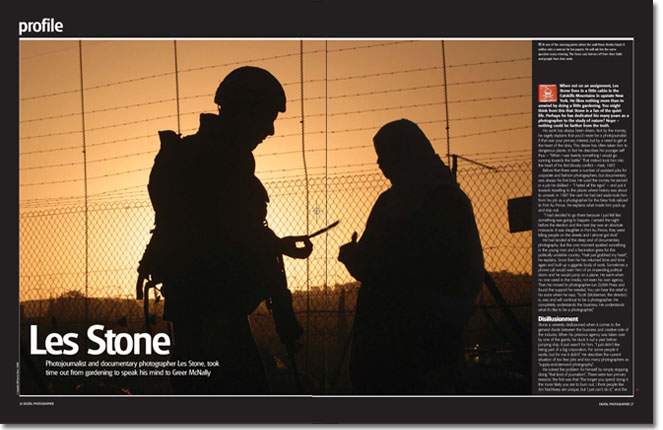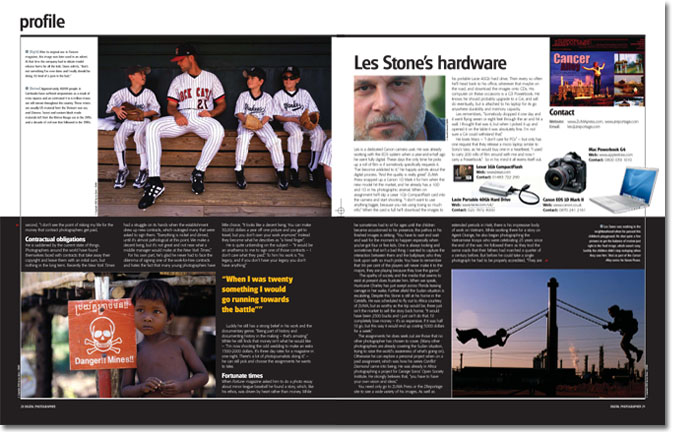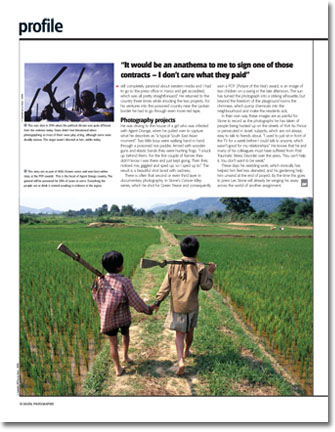Profile: Les Stone
Source: Digital Photographer
October 1, 2004
Digital Photographer chronicles the award-winning career and experiences of ZUMA Press photojournalist Les Stone. Below is the text from the five page spread as published in the October 1, 2004 issue.


Cover Photograph: At one of the crossing points where the wall/fence divides Israel. A
soldier asks a woman for her papers. He will ask her the same
question every morning. The fence cuts farmers off from their fields
and people from their work.
Digital Les Stone
Photojournalist and documentary photographer
Les Stone, took time out from gardening to speak his mind to Greer
McNally
When not on an assignment, Les Stone lives
in a little cabin in the Catskills Mountains in upstate New York.
He likes nothing more than to unwind by doing a little gardening.
You might think from this that Stone is a fan of the quiet life.
Perhaps he has dedicated his many years as a photographer to the
study of nature? Nope nothing could be farther from the truth.
His work has always been driven. Not by
the money, he sagely explains that you'd never be a photojournalist
if that was your primary interest, but by a need to get at the heart
of the story. This desire has often taken him to dangerous places.
In fact he describes his younger self thus "When I was twenty
something I would go running towards the battle." That instinct
took him into the heart of his first bloody conflict Haiti, 1987.
Before that there were a number of assistant
jobs for corporate and fashion photographers, but documentary was
always his first love. He used the money he earned in a job he disliked
"I hated all the egos" and put it towards travelling to the
places where history was about to unravel. In 1987 the cash he had
laid aside took him from his job as a photographer for the New York
railroad to Port Au Prince. He explains what made him pack up and
ship out.
"I had decided to go there because I just
felt like something was going to happen. I arrived the night before
the election and the next day was an absolute massacre. It was slaughter
in Port Au Prince, they were killing people on the streets and I
almost got shot." He had landed at the deep end of documentary photography.
But this one moment sparked something in the young man and a fascination
grew for this politically unstable country. "Haiti just grabbed
my heart", he explains. Since then he has returned time and time
again and built up a gigantic body of work. Sometimes a phone call
would warn him of an impending political storm and he would jump
on a plane. He went when no one cared in the media, not even his
own agency. Then he moved to photographer-run ZUMA Press and found
the support he needed. You can hear the relief in his voice when
he says, "Scott (McKiernan, the director) is, was and will continue
to be a photographer. He completely understands the business. He
understands what it's like to be a photographer."
Disillusionment
Stone is severely disillusioned when it
comes to the general divide between the business and creative side
of the industry. When his previous agency was taken over by one
of the giants, he stuck it out a year before jumping ship. It just
wasn't for him. "I just didn't like being part of a big corporation.
For some people it works, but for me it didn't." He describes the
current situation of too few jobs and too many photographers as
"supply-and-demand photography".
He solved the problem for himself by simply
stopping doing "that kind of journalism". There were two primary
reasons: the first was that "the longer you spend doing it the more
likely you are to burn out. I think people like Jim Nachtwey are
unique, but I just can't do it," and the second, "I don't see the point of risking my life for the
money that contract photographers get paid."

Photographs:
[Left Page-Right] After its original use in Fortune magazine, this
image was later used in an advert. At that time the company had to
obtain model release forms for all the kids. Stone admits, "that's
not something I've ever done and I really should be doing. It's kind
of a pain in the butt."
[Left Page-Below] Approximately 40,000 people
in Cambodia have suffered amputations as a result of mine injuries
and an estimated 4 to 6 million mines are still strewn throughout
the country. These mines are usually US material from the Vietnam
war era, and Chinese, Soviet and eastern block made materials left
from the Khmer Rouge era in the 1970s and a decade of civil war
that followed in the 1980s.
[Right Page-Below] Les Stone was working in the
neighbourhood when he passed this
children's playground. He shot quite a few
pictures to get the balance of motion just
right in the final image, which wasn't easy.
Luckily the children didn’t stop swinging when
they saw him. Shot as part of the Cancer
Alleyseries for Green Peace.
Contractual obligations
He is saddened by the current state of things.
Photographers around the world have found
themselves faced with contracts that take away their
copyright and leave them with an initial sum, but
nothing in the long term. Recently the New York Times had a struggle on its hands when the establishment
drew up new contracts, which outraged many that were
asked to sign them. "Everything is nickel and dimed,
until it's almost pathological at this point. We make a
decent living, but it's not great and not near what a
middle manager would make at the New York Times."
For his own part, he's glad he never had to face the
dilemma of signing one of the work-for-hire contracts
and hates the fact that many young photographers have little choice. "It looks like a decent living. You can make
50,000 dollars a year off one picture and you get to
travel, but you don't own your work anymore." Instead
they become what he describes as "a hired finger".
He is quite unbending on the subject "It would be
an anathema to me to sign one of those contracts I
don't care what they paid." To him his work is "his
legacy, and if you don't have your legacy you don’t
have anything."
Luckily he still has a strong belief in his work and the
documentary genre. "Being part of history and
documenting history in the making that's amazing."
While he still finds that money isn't what he would like
"I'm now shooting the odd wedding to make an extra
1500-2000 dollars. It's three day rates for a magazine in
one night. There's a lot of photojournalists doing it."
he can still pick and choose the assignments he wants
to take.
Fortunate times
When Fortune magazine asked him to do a photo essay
about minor league baseball he found a story, which, like
his ethos, was driven by heart rather than money. While he sometimes had to sit for ages until the children
became accustomed to his presence, the pathos in his
finished images is striking. "You have to wait and wait
and wait for the moment to happen especially when
you've got four or five kids. One is always looking and
sometimes that isn't a bad thing. I wanted to capture the
interaction between them and the ballplayer, who they
look upon with so much pride. You have to remember
that 99 per cent of the players will never make it to the
majors, they are playing because they love the game."
The apathy of society and the media that seems to
exist at present does frustrate him. When we speak,
Hurricane Charley has just swept across Florida leaving
carnage in her wake. Further afield the Sudan situation is
escalating. Despite this Stone is still at his home in the
Catskills. He was scheduled to fly out to Africa courtesy
of ZUMA, but as worthy as the trip would be, there just
isn't the market to sell the story back home. "It would
have been 2500 bucks and I just can't do that. I'd
completely lose money it's so expensive. If it was half
I'd go, but this way it would end up costing 5000 dollars
for a week."
The assignments he does seek out are those that no
other photographer has chosen to cover. (Many other
photographers are already covering the Sudan situation,
trying to raise the world's awareness of what's going on).
Otherwise he can explore a personal project when on a
paid assignment, which was how his series Conflict
Diamond came into being. He was already in Africa
photographing a project for George Soros' Open Society
Institute. He strongly believes that, “you have to have
your own vision and ideas.”
You need only go to ZUMA Press or the zReportage
site to see a wide variety of his images. As well as extended periods in Haiti, there is his impressive body
of work on Vietnam. While working there for a story on
Agent Orange, he also began photographing the
Vietnamese troops who were celebrating 25 years since
the end of the war. He followed them as they trod the
same roads that their fathers had marched a quarter of
a century before. But before he could take a single
photograph he had to be properly accredited. "They are still completely paranoid about western media and I had
to go to the press office in Hanoi and get accredited,
which was all pretty straightforward." He returned to the
country three times while shooting the two projects. For
his ventures into the poisoned country near the Laotian
border he had to go through even more red tape.

Photographs:
[Top Left] This was shot in 1994 when the political climate was quite different
from the violence today. Stone didn't feel threatened when
photographing as most of them were play acting, although some were
deadly serious. The anger wasn't directed at him, unlike today.
[Below]
This story ran as part of AOL's Visions series and won best online
story at the POY awards. This is the heart of Agent Orange country. The
ground will be poisoned for 100s of years to come. Everything the
people eat or drink is tainted resulting in sickness in the region.
Photography projects
He was driving to the house of a girl who was infected
with Agent Orange, when he pulled over to capture
what he describes as "a typical South East Asian
moment". Two little boys were walking hand in hand
through a poisoned rice paddie. Armed with wooden
guns and elastic bands they were hunting frogs. "I snuck
up behind them. For the first couple of frames they
didn't know I was there and just kept going. Then they
noticed me, giggled and sped up, so I sped up to." The
result is a beautiful shot laced with sadness.
There is often that second or even third layer in
documentary photography. In Stone's Cancer Alley
series, which he shot for Green Peace and consequently won a POY (Picture of the Year) award, is an image of
two children on a swing in the late afternoon. The sun
has turned the photograph into a striking silhouette, but
beyond the freedom of the playground looms the
chimneys, which pump chemicals into the
neighbourhood and make the residents sick.
In their own way these images are as painful for
Stone to record as the photographs he has taken of
people being hacked up on the streets of Port Au Prince
or persecuted in Israel: subjects, which are not always
easy to talk to friends about. "I used to just sit in front of
the TV for a week before I could talk to anyone, which
wasn't good for my relationships." He knows that he and
many of his colleagues must have suffered from Post
Traumatic Stress Disorder over the years. "You can't help
it. You don’t want to be weak."
These days his wedding work, which ironically has
helped him feel less alienated, and his gardening help
him unwind at the end of project. By the time this goes
to press Les Stone will already be winging his away
across the world of another assignment.
Les Stone's hardware
Les is a dedicated Canon camera user. He was already
working with the EOS system when a year-and-a-half ago
he went fully digital. These days the only time he picks
up a roll of film is if somebody specifically requests it.
"I've become addicted to it," he happily admits about the
digital process. "And the quality is really great.” ZUMA
Press snapped up a Canon 1D Mark II for him when the
new model hit the market, and he already has a 10D
and 1D in his photographic arsenal. When on
assignment he'll slip a Lexar 1Gb CompactFlash card into
the camera and start shooting. "I don't want to use
anything bigger, because you risk using losing so much
info." When the card is full he'll download the images to
his portable Lacie 40Gb hard drive. Then every so often
he'll head back to his office, wherever that maybe on
the road, and download the images onto CDs. His
computer on these occasions is a G3 Powerbook. He
knows he should probably upgrade to a G4, and will
do eventually, but is attached to his laptop for its go
anywhere durability and memory capacity.
Les remembers, "Somebody dropped it one day and
it went flying seven or eight feet through the air and hit a
wall. I thought that was it, but when I picked it up and
opened it on the table it was absolutely fine. I'm not
sure a G4 could withstand that."
He loves Macs "I don't care for PCs" but only has
one request that they release a micro laptop similar to
Sony's Vaio, as he would buy one in a heartbeat. "I used
to carry 200 rolls of film around with me and now I
carry a Powerbook." So in his mind it all evens itself out.
Contact
Website: www.ZUMApress.com, www.zreportage.com,
Email: les@zreportage.com
Equipment
Lexar 1Gb CompactFlash
Web: www.lexar.com
Contact: 01483 722 290
Lacie Portable 40Gb Hard Drive
Web: www.lacie.com/uk/
Contact: 020 7872 8000
Canon EOS 1D Mark II
Web: www.canon.co.uk
Contact: 0870 241 2161
Mac Powerbook G4
Web: www.applestore.com
Contact: 0800 039 1010
|
|